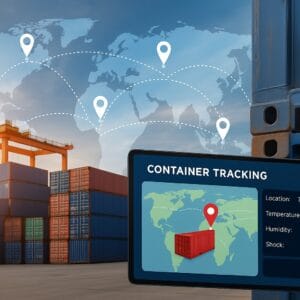Global shipping is messy, and often chaotic. Containers zigzag across oceans, ports get jammed, customs slow things down, and somewhere in the middle of it all, your cargo might just vanish into a black hole of “in transit” status. Sound familiar?

That’s where container tracking software steps in. Not the cheap, clunky kind. We’re talking high-quality, real-time, sensor-integrated systems that actually do what they promise.
Visibility Isn’t a Luxury Anymore; It’s Survival
Back in the day, tracking a container meant calling someone. Or waiting for an email. Or worse, relying on a port’s website that hadn’t been updated since last Tuesday. Fast forward to 2025. Visibility is no longer optional. It’s the backbone of logistics.
High-quality container tracking software gives you real-time updates. Not just “left port” or “arrived at terminal.” We’re talking granular stuff, like GPS coordinates, temperature, humidity, shock levels. You know, the kind of data that actually helps you make decisions.
And it’s not just about knowing where your stuff is. It’s about knowing what condition it’s in. Especially if you’re shipping perishables, pharmaceuticals, or anything remotely sensitive. IoT sensors embedded in containers now feed live data into centralized dashboards. That’s not sci-fi. That’s standard.
Efficiency, The Silent Killer of Cost
Let’s be real. Logistics is expensive. Fuel, labor, storage, rerouting — it adds up. But here’s the kicker: most of those costs stem from inefficiencies. Containers sitting idle. Wrong routes. Missed connections.
Investing in high-quality tracking software helps you spot those inefficiencies before they bleed your budget dry. Real-time data means better coordination between ports, warehouses, and carriers. You can reroute shipments on the fly, avoid bottlenecks, and reduce detention fees.
In 2025, companies using advanced tracking systems reported up to 20% reduction in operational costs. That’s not pocket change. That’s payroll, fuel, and overhead.
Security Is Paramount
Cargo theft isn’t just a plotline in heist movies. It’s real. And it’s costly. High-end tracking software doesn’t just tell you where your container is. It alerts you when something’s off. Unauthorized access? You’ll know. Temperature spike? You’ll know. Container opened mid-route. Certainly, you will know.
Some systems even use blockchain to log every movement and transaction. That means tamper-proof records. No more “he said, she said” with customs or insurance.
Not Just Tracking, But Forecasting
Here’s where things get interesting. The best container tracking software doesn’t just react, it predicts. Using machine learning, these systems analyze historical data, weather patterns, port congestion, and other factors to forecast delays before they occur.
Imagine knowing your shipment will be late before it even leaves the port. That’s the kind of foresight that changes how you plan inventory, staffing, and customer communication.
Scalability Is Paramount
Let’s say your business is booming. Great. But can your logistics keep up?
High-quality container tracking software is built to scale. Cloud-based platforms mean you’re not stuck with clunky on-premises systems. You can add users, integrate with other tools, and expand globally without rebuilding your tech stack.
And with global trade projected to grow by 4–5% annually through 2030, scalability isn’t just nice to have, it’s essential.
Regulatory Compliance
2025 isn’t kind to companies that ignore compliance. Governments are tightening regulations around cargo visibility, data security, and environmental impact. High-end tracking software helps you stay ahead of the curve.
Automated logs, real-time documentation, and secure data sharing make audits less painful. And if you’re shipping across borders, that kind of compliance can mean the difference between smooth sailing and a customs nightmare.
The Investment Case — Why It’s Worth the Money
Let’s talk numbers. The container tracking software market is projected to hit $6 billion by 2033, growing at a 15% CAGR. That’s not hype, that’s demand.
Companies are pouring money into smarter logistics like self bunded fuel tank and software. Not because it’s trendy, but because it works. Better tracking means fewer delays, happier customers, and leaner operations.
Sure, the upfront cost can sting. But the ROI? It’s solid. Especially when you factor in reduced losses, improved planning, and faster turnaround.
Is It Worth It?
In simple words, the answer is yes.
Here’s the rationale behind the answer. If you’re still relying on spreadsheets, emails, or outdated tracking portals, you’re playing a losing game.
High-quality container tracking software isn’t just a tool, it’s a strategy. One that pays off in visibility, efficiency, security, and peace of mind. So, ask yourself can you afford not to invest?



